warning YAMAHA GIGGLE50 2009 Owner's Manual
[x] Cancel search | Manufacturer: YAMAHA, Model Year: 2009, Model line: GIGGLE50, Model: YAMAHA GIGGLE50 2009Pages: 74, PDF Size: 0.9 MB
Page 47 of 74

6-47
1
2
3
4
5
6
7
8
9
EAU1722A
PERIODIC MAINTENANCE AND ADJUSTMENT
6-12
EAU21382
Checking the throttle cable
free playThe throttle cable free play should mea-
sure 1.5~3.5 mm (0.06~0.14 in) at the
throttle grip. Periodically check the
throttle cable free play and, if necessary,
have a Yamaha dealer adjust it. Throttle cable free play, checking
Valve clearance
Tires
EAU21401
Valve clearanceThe valve clearance changes with use,
resulting in improper air-fuel mixture and/
or engine noise. To prevent this from
occurring, the valve clearance must be
adjusted by a Yamaha dealer at the in-
tervals specified in the periodic mainte-
nance and lubrication chart.
EAUT2141
TiresTo maximize the performance, durabil-
ity, and safe operation of your vehicle,
note the following points regarding the
specified tires.
Tire air pressure
The tire air pressure should be checked
and, if necessary, adjusted before each
ride.
EWA10501
WARNING
Operation of this vehicle with im-
proper tire pressure may cause se-
vere injury or death from loss of con-
trol.
8 88 8
8The tire air pressure must be
checked and adjusted on cold
tires (i.e., when the temperature
of the tires equals the ambient
temperature).
8 88 8
8The tire air pressure must be
adjusted in accordance with the
riding speed and with the total
weight of rider, passenger, cargo,
Page 48 of 74

6-48
1
2
3
4
5
6
7
8
9
EAU1722A
PERIODIC MAINTENANCE AND ADJUSTMENT
6-13
and accessories approved for this
model.Tire air pressure (measured on cold
tires):
Up to 90 kg (198 lb):
Front:
175 kPa (1.75 kgf/cm
2, 25 psi)
Rear:
175 kPa (1.75 kgf/cm2, 25 psi)
90 kg (198 lb) to maximum load:
Front:
175 kPa (1.75 kgf/cm2, 25 psi)
Rear:
175 kPa (1.75 kgf/cm2, 25 psi)
Maximum load*:
177 kg (390 lb)
* Total weight of rider, passenger,
cargo and accessories
EWA10511
WARNING
Never overload your vehicle. Opera-
tion of an overloaded vehicle could
cause an accident.
Tire inspectionZAUM00**
1
2
1. Tire tread depth
2. Tire sidewallThe tires must be checked before each
ride. If the center tread depth reaches
the specified limit, if the tire has a nail
or glass fragments in it, or if the sidewall
is cracked, have a Yamaha dealer re-
place the tire immediately.Minimum tire tread depth (front and
rear):
0.8 mm (0.03 in)
TIP
The tire tread depth limits may differ from
country to country. Always comply with
the local regulations.Tire information
This model is equipped with tubeless
tires.
After extensive tests, only the tires
listed below have been approved for this
model by Yamaha Motor Co., Ltd.Front tire:
Size:
120/90-10 57J
Manufacturer/model:
CHENG SHIN/C-6022
Rear tire:
Size:
120/90-10 57J
Manufacturer/model:
CHENG SHIN/C-6022
EWA10470
WARNING
8 88 8
8Have a Yamaha dealer replace
excessively worn tires. Besides
Page 50 of 74
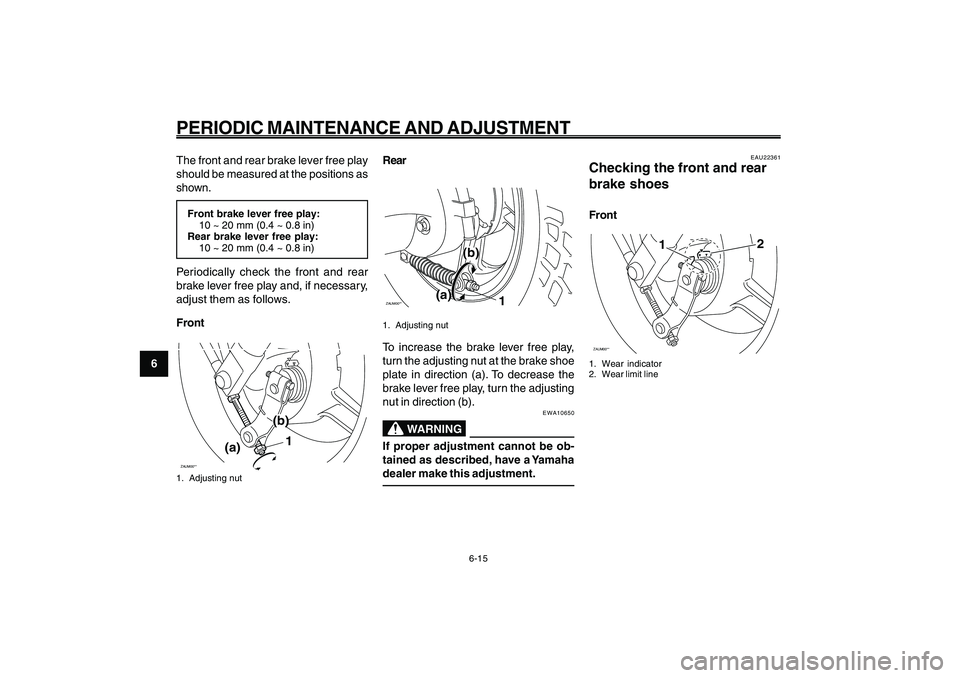
6-50
1
2
3
4
5
6
7
8
9
EAU1722A
PERIODIC MAINTENANCE AND ADJUSTMENT
6-15
The front and rear brake lever free play
should be measured at the positions as
shown.Front brake lever free play:
10 ~ 20 mm (0.4 ~ 0.8 in)
Rear brake lever free play:
10 ~ 20 mm (0.4 ~ 0.8 in)Periodically check the front and rear
brake lever free play and, if necessary,
adjust them as follows.
FrontZAUM00**
1
(b)
(a)
1. Adjusting nut
RearZAUM00**
1
(b)
(a)
1. Adjusting nutTo increase the brake lever free play,
turn the adjusting nut at the brake shoe
plate in direction (a). To decrease the
brake lever free play, turn the adjusting
nut in direction (b).
EWA10650
WARNING
If proper adjustment cannot be ob-
tained as described, have a Yamaha
dealer make this adjustment.
Brake shoes, checking
EAU22361
Checking the front and rear
brake shoesFrontZAUM00**
2
1
1. Wear indicator
2. Wear limit line
Page 52 of 74
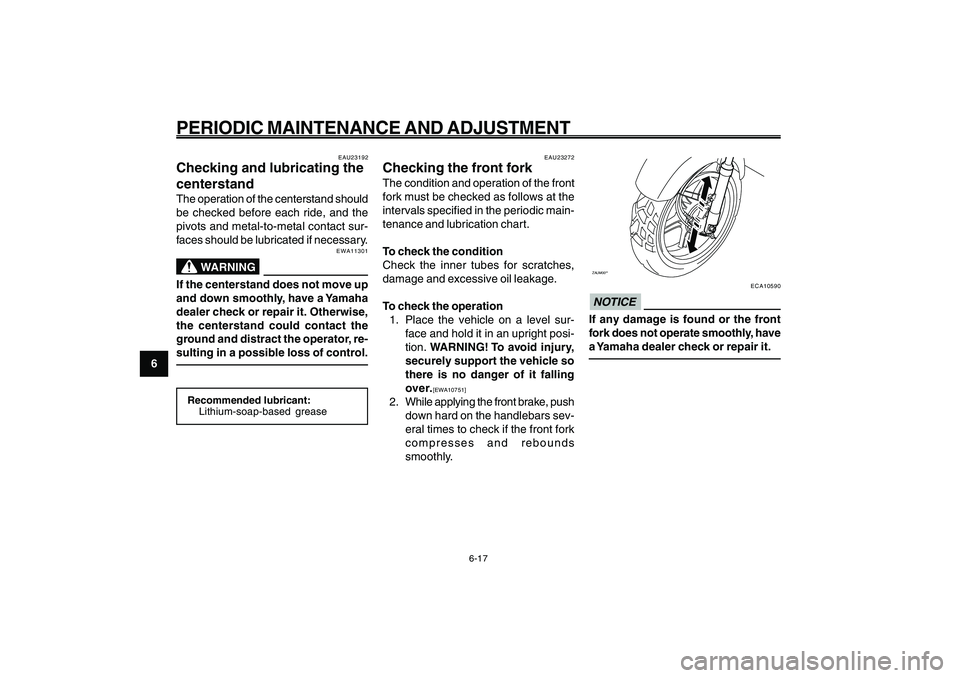
6-52
1
2
3
4
5
6
7
8
9
EAU1722A
PERIODIC MAINTENANCE AND ADJUSTMENT
6-17
Centerstand, checking and lubricating
Front fork, checking
EAU23192
Checking and lubricating the
centerstandThe operation of the centerstand should
be checked before each ride, and the
pivots and metal-to-metal contact sur-
faces should be lubricated if necessary.
EWA11301
WARNING
If the centerstand does not move up
and down smoothly, have a Yamaha
dealer check or repair it. Otherwise,
the centerstand could contact the
ground and distract the operator, re-
sulting in a possible loss of control.Recommended lubricant:
Lithium-soap-based grease
EAU23272
Checking the front forkThe condition and operation of the front
fork must be checked as follows at the
intervals specified in the periodic main-
tenance and lubrication chart.
To check the condition
Check the inner tubes for scratches,
damage and excessive oil leakage.
To check the operation
1. Place the vehicle on a level sur-
face and hold it in an upright posi-
tion. WARNING! To avoid injury,
securely support the vehicle so
there is no danger of it falling
over.
[EWA10751]
2. While applying the front brake, push
down hard on the handlebars sev-
eral times to check if the front fork
compresses and rebounds
smoothly.
ZAUM00**
ECA10590
NOTICEIf any damage is found or the front
fork does not operate smoothly, have
a Yamaha dealer check or repair it.
Page 53 of 74
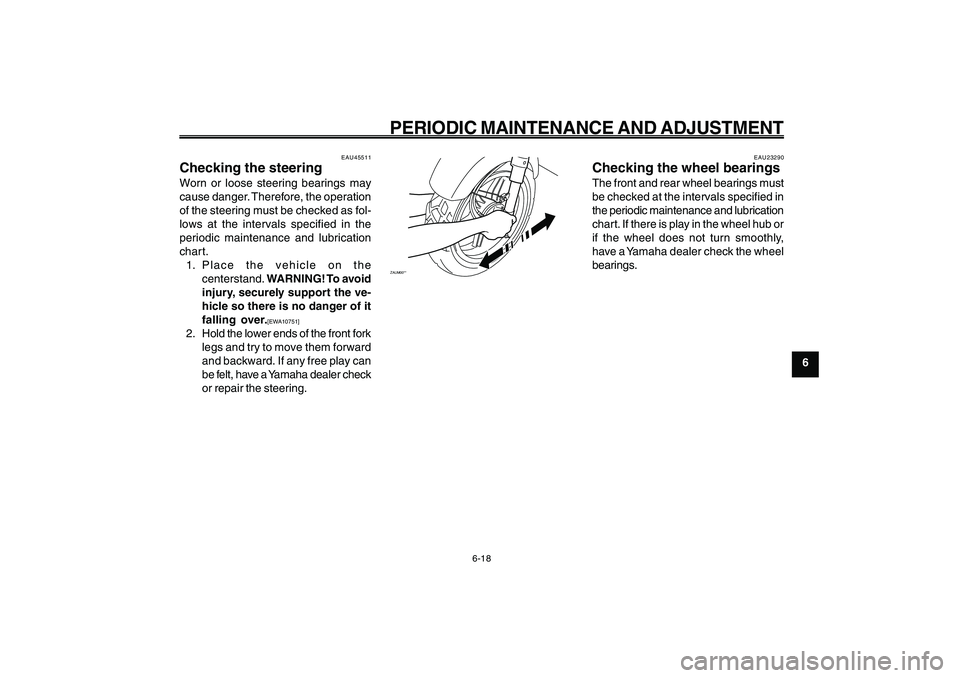
6-53
1
2
3
4
5
6
7
8
9
EAU1722A
PERIODIC MAINTENANCE AND ADJUSTMENT
6-18
Steering, checking
Wheel bearings, checking
EAU45511
Checking the steeringWorn or loose steering bearings may
cause danger. Therefore, the operation
of the steering must be checked as fol-
lows at the intervals specified in the
periodic maintenance and lubrication
chart.
1. Place the vehicle on the
centerstand. WARNING! To avoid
injury, securely support the ve-
hicle so there is no danger of it
falling over.
[EWA10751]
2. Hold the lower ends of the front fork
legs and try to move them forward
and backward. If any free play can
be felt, have a Yamaha dealer check
or repair the steering.
ZAUM00**
EAU23290
Checking the wheel bearingsThe front and rear wheel bearings must
be checked at the intervals specified in
the periodic maintenance and lubrication
chart. If there is play in the wheel hub or
if the wheel does not turn smoothly,
have a Yamaha dealer check the wheel
bearings.
Page 54 of 74
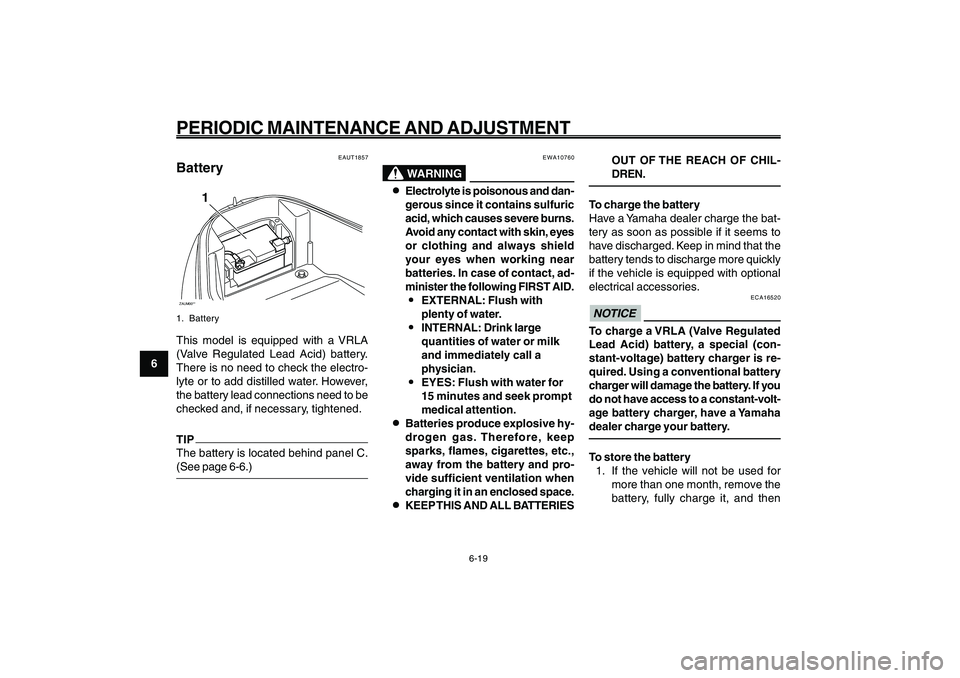
6-54
1
2
3
4
5
6
7
8
9
EAU1722A
PERIODIC MAINTENANCE AND ADJUSTMENT
6-19
EAUT1857
BatteryZAUM00**
1
1. BatteryThis model is equipped with a VRLA
(Valve Regulated Lead Acid) battery.
There is no need to check the electro-
lyte or to add distilled water. However,
the battery lead connections need to be
checked and, if necessary, tightened.TIP
The battery is located behind panel C.
(See page 6-6.)Battery
EWA10760
WARNING
8 88 8
8Electrolyte is poisonous and dan-
gerous since it contains sulfuric
acid, which causes severe burns.
Avoid any contact with skin, eyes
or clothing and always shield
your eyes when working near
batteries. In case of contact, ad-
minister the following FIRST AID.
9 99 9
9EXTERNAL: Flush with
plenty of water.
9 99 9
9INTERNAL: Drink large
quantities of water or milk
and immediately call a
physician.
9 99 9
9EYES: Flush with water for
15 minutes and seek prompt
medical attention.
8 88 8
8Batteries produce explosive hy-
drogen gas. Therefore, keep
sparks, flames, cigarettes, etc.,
away from the battery and pro-
vide sufficient ventilation when
charging it in an enclosed space.
8 88 8
8KEEP THIS AND ALL BATTERIESOUT OF THE REACH OF CHIL-
DREN.
To charge the battery
Have a Yamaha dealer charge the bat-
tery as soon as possible if it seems to
have discharged. Keep in mind that the
battery tends to discharge more quickly
if the vehicle is equipped with optional
electrical accessories.
ECA16520
NOTICETo charge a VRLA (Valve Regulated
Lead Acid) battery, a special (con-
stant-voltage) battery charger is re-
quired. Using a conventional battery
charger will damage the battery. If you
do not have access to a constant-volt-
age battery charger, have a Yamaha
dealer charge your battery.To store the battery
1. If the vehicle will not be used for
more than one month, remove the
battery, fully charge it, and then
Page 55 of 74
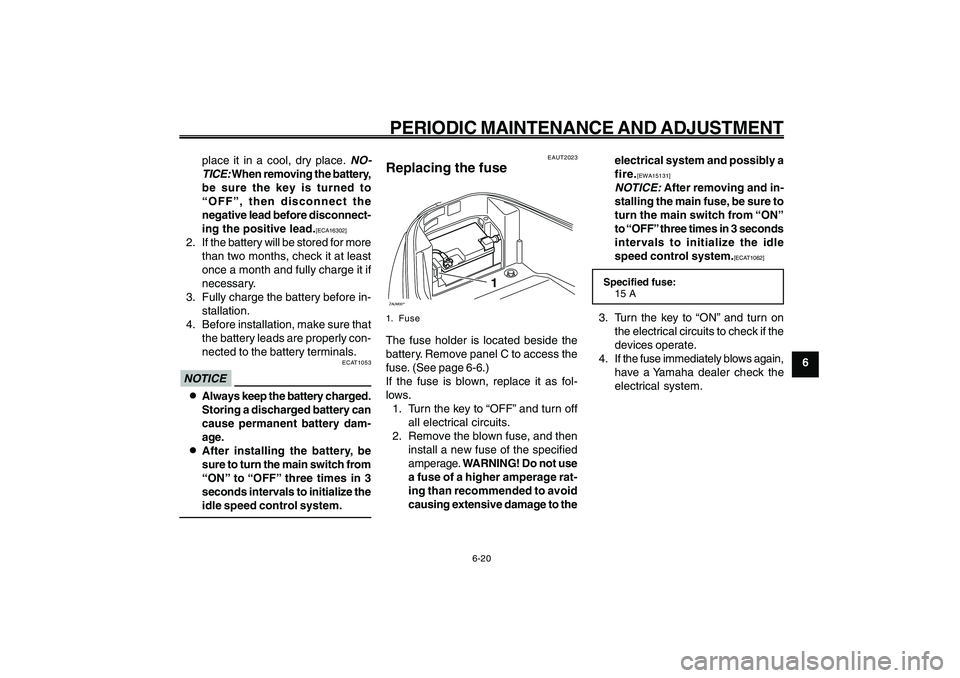
6-55
1
2
3
4
5
6
7
8
9
EAU1722A
PERIODIC MAINTENANCE AND ADJUSTMENT
6-20
place it in a cool, dry place.
NO-
TICE:
When removing the battery,
be sure the key is turned to
“OFF”, then disconnect the
negative lead before disconnect-
ing the positive lead.
[ECA16302]
2. If the battery will be stored for more
than two months, check it at least
once a month and fully charge it if
necessary.
3. Fully charge the battery before in-
stallation.
4. Before installation, make sure that
the battery leads are properly con-
nected to the battery terminals.
ECAT1053
NOTICE8 88 8
8Always keep the battery charged.
Storing a discharged battery can
cause permanent battery dam-
age.
8 88 8
8After installing the battery, be
sure to turn the main switch from
“ON” to “OFF” three times in 3
seconds intervals to initialize the
idle speed control system.Fuse, replacing
EAUT2023
Replacing the fuseZAUM00**
1
1. FuseThe fuse holder is located beside the
battery. Remove panel C to access the
fuse. (See page 6-6.)
If the fuse is blown, replace it as fol-
lows.
1. Turn the key to “OFF” and turn off
all electrical circuits.
2. Remove the blown fuse, and then
install a new fuse of the specified
amperage. WARNING! Do not use
a fuse of a higher amperage rat-
ing than recommended to avoid
causing extensive damage to theelectrical system and possibly a
fire.
[EWA15131]
NOTICE:
After removing and in-
stalling the main fuse, be sure to
turn the main switch from “ON”
to “OFF” three times in 3 seconds
intervals to initialize the idle
speed control system.
[ECAT1062]
Specified fuse:
15 A3. Turn the key to “ON” and turn on
the electrical circuits to check if the
devices operate.
4. If the fuse immediately blows again,
have a Yamaha dealer check the
electrical system.
Page 58 of 74
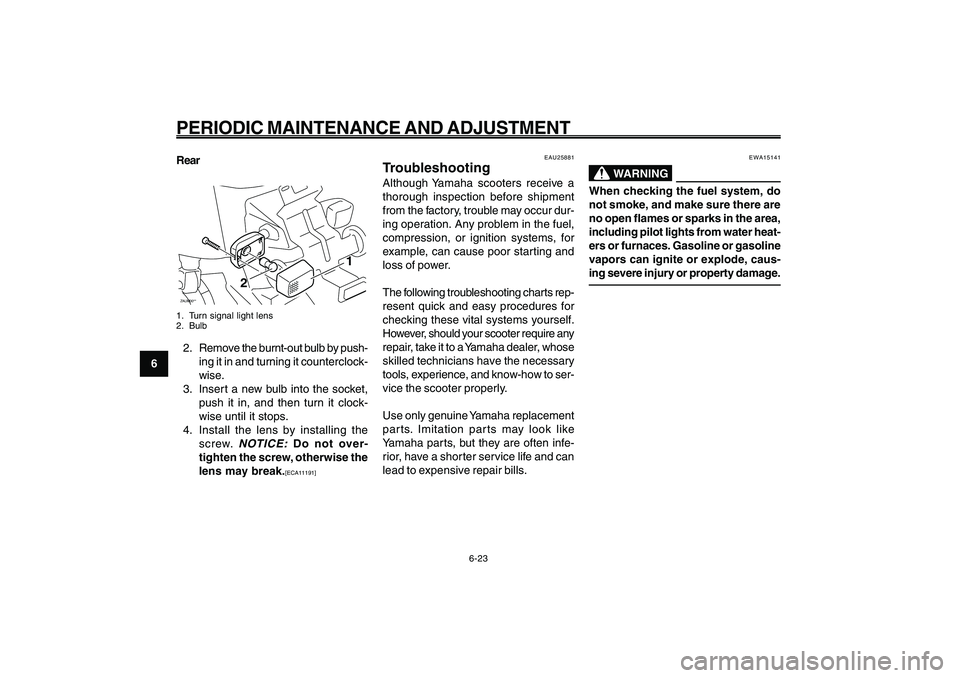
6-58
1
2
3
4
5
6
7
8
9
EAU1722A
PERIODIC MAINTENANCE AND ADJUSTMENT
6-23
EWA15141
WARNING
When checking the fuel system, do
not smoke, and make sure there are
no open flames or sparks in the area,
including pilot lights from water heat-
ers or furnaces. Gasoline or gasoline
vapors can ignite or explode, caus-
ing severe injury or property damage.
EAU25881
TroubleshootingAlthough Yamaha scooters receive a
thorough inspection before shipment
from the factory, trouble may occur dur-
ing operation. Any problem in the fuel,
compression, or ignition systems, for
example, can cause poor starting and
loss of power.
The following troubleshooting charts rep-
resent quick and easy procedures for
checking these vital systems yourself.
However, should your scooter require any
repair, take it to a Yamaha dealer, whose
skilled technicians have the necessary
tools, experience, and know-how to ser-
vice the scooter properly.
Use only genuine Yamaha replacement
parts. Imitation par ts may look like
Yamaha parts, but they are often infe-
rior, have a shorter service life and can
lead to expensive repair bills. Troubleshooting
Rear
ZAUM00**
1
2
1. Turn signal light lens
2. Bulb2. Remove the burnt-out bulb by push-
ing it in and turning it counterclock-
wise.
3. Insert a new bulb into the socket,
push it in, and then turn it clock-
wise until it stops.
4. Install the lens by installing the
screw.
NOTICE:
Do not over-
tighten the screw, otherwise the
lens may break.[ECA11191]
Page 60 of 74

6-60
1
2
3
4
5
6
7
8
9
EAU1722A
PERIODIC MAINTENANCE AND ADJUSTMENT
6-25
Wait until the
engine has cooled.
Check the coolant level in the
reservoir and radiator.
The coolant level
is OK.The coolant level is low.
Check the cooling system
for leakage.
Have a Yamaha dealer checkand repair the cooling system.Add coolant. (See TIP.)
Start the engine. If the engine overheats again,
have a
Yamaha dealer check
and repair the cooling system.
There is
leakage.
There is
no leakage.
Engine overheating
EWAT1040
WARNING
8 88 8
8Do not remove the radiator cap when the engine and radiator are hot. Scalding hot fluid and steam may be
blown out under pressure, which could cause serious injury. Be sure to wait until the engine has cooled.
8 88 8
8Place a thick rag, like a towel, over the radiator cap, and then slowly rotate the cap counterclockwise to the
detent to allow any residual pressure to escape. When the hissing sound has stopped, press down on the cap
while turning it counterclockwise, and then remove the cap.TIP
If coolant is not available, tap water can be temporarily used instead, provided that it is changed to the recommended coolant
as soon as possible.
Page 63 of 74
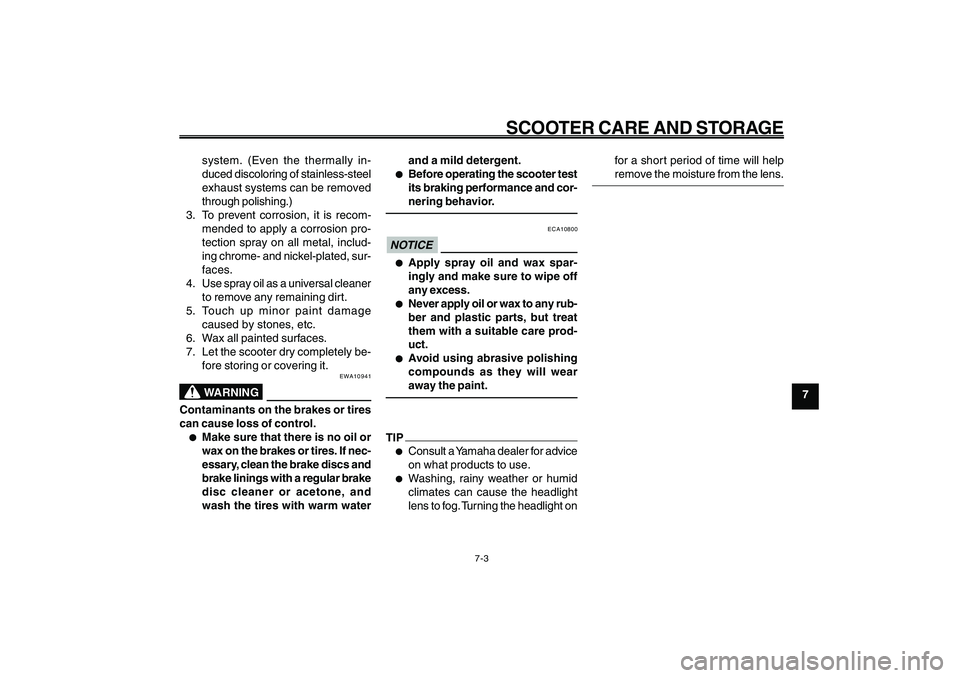
7-63
1
2
3
4
5
6
7
8
9
EAU25991
SCOOTER CARE AND STORAGE
7-3
system. (Even the thermally in-
duced discoloring of stainless-steel
exhaust systems can be removed
through polishing.)
3. To prevent corrosion, it is recom-
mended to apply a corrosion pro-
tection spray on all metal, includ-
ing chrome- and nickel-plated, sur-
faces.
4. Use spray oil as a universal cleaner
to remove any remaining dirt.
5. Touch up minor paint damage
caused by stones, etc.
6. Wax all painted surfaces.
7. Let the scooter dry completely be-
fore storing or covering it.
EWA10941
WARNING
Contaminants on the brakes or tires
can cause loss of control.● ●● ●
●
Make sure that there is no oil or
wax on the brakes or tires. If nec-
essary, clean the brake discs and
brake linings with a regular brake
disc cleaner or acetone, and
wash the tires with warm waterand a mild detergent.
● ●● ●
●
Before operating the scooter test
its braking performance and cor-
nering behavior.
ECA10800
NOTICE● ●● ●
●
Apply spray oil and wax spar-
ingly and make sure to wipe off
any excess.
● ●● ●
●
Never apply oil or wax to any rub-
ber and plastic parts, but treat
them with a suitable care prod-
uct.
● ●● ●
●
Avoid using abrasive polishing
compounds as they will wear
away the paint.
TIP●
Consult a Yamaha dealer for advice
on what products to use.
●
Washing, rainy weather or humid
climates can cause the headlight
lens to fog. Turning the headlight onfor a short period of time will help
remove the moisture from the lens.